YOUR CART
- No products in the cart.
Subtotal:
$0.00

Artists are known for their observation skills. Indeed, capturing a magnificent sunset or the smiling wrinkles on a grandmother’s face requires close examination and study.
But some very special artists use their observation skills in a different way. They look for the quiet beauty of everyday objects that are often overlooked: a worn coin lying on the pavement, an intricate feather beside a footpath, or even the shiny foil lid of a yoghurt pot. These ‘found objects’ become artistic tokens that connect to a particular time and place.
Found object art is a delight for both artist and viewer. The element of surprise doesn’t only rest with the maker. Viewers experience the same excitement when they stumble across an unexpected object an artist has physically embedded in her work. Oh look! That shimmering bauble is actually a sweet wrapper!
We’re delighted to introduce you to five different artists who showcase the treasures they’ve found by paying careful attention to life’s details. Alice Fox takes us to the beach, but it’s not shells she’s collecting. Hillary Waters Fayle ventures into the woods to find leaves on which to stitch. Hannah Reeves and Ulla-Stina Wikander share their ingenious flea market creations, and Jessica Grady re-introduces you to your rubbish bin.
It’s all quite fun and remarkable!
The saying ‘trash to treasure’ is an understatement when it comes to Jessica Grady’s textile art. Working with objects normally sent to landfills, Jessica creates whimsical art that both surprises and delights.
Her favourite finds include plastic lids from milk bottles, coffee pods and soft drinks that she uses as 3D support for her mini embroideries. The lids are dyed, painted or wrapped to enhance their look. She also cherishes a big bundle of old electric cables she found at a recycling centre. The tangled colours and striped wires can be used as thread to provide texture and vertical support for stitching.
‘I love using unexpected found items in my textile works. And I particularly enjoy changing the use of something and giving it a new lease on life as a beautiful embellishment idea. Found objects add a layer of storytelling. Each embellishment has been on its own journey, and it’s a pleasure to share those stories with my customers.’
This work inspired by coral and underwater forms is created from multiple layers of depth, texture and pattern that can be viewed from every direction. Jessica first created all the embellishments from recycled materials that included coffee pods, wire-wrapped plant rings, dyed medical tubing, recycled parcel ribbon, painted wooden sequins, sliced foam and tapestry wool.
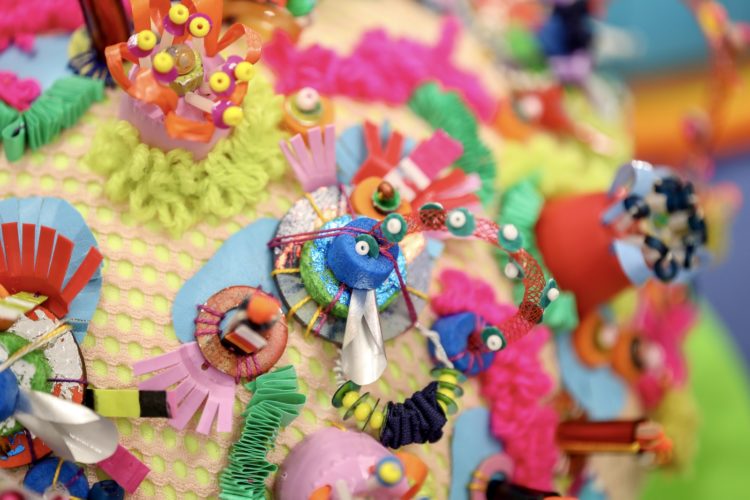
Jessica then sampled different motifs on the fabric base, looking at how the colours and shape bounced off each other. When pleased with the final design, everything was hand stitched onto the base. Not one dab of glue was used.
‘One of the greatest challenges is creating small structures and areas of intricate detail that will pop out and add depth when the fabric is moulded into its final 3D shape. While some elements look great on a flat surface, they don’t have that same zing when pulled around a curve.’
To layer her work, Jessica begins with the largest pieces first, and then the details get smaller as she layers upward. Embroidery stitches are the final flourish, helping secure embellishments while also adding pattern and design. She relies upon basic stitches, such as straight stitch, couching, chain stitch and French knots.
‘I’m passionate about utilising mixed media and recycled materials. The juxtaposition of those items with traditional stitching techniques invites the viewer in for a closer look. My continued experimentation also means I’ll never run out of new ideas for unusual materials I can stitch onto fabrics!’
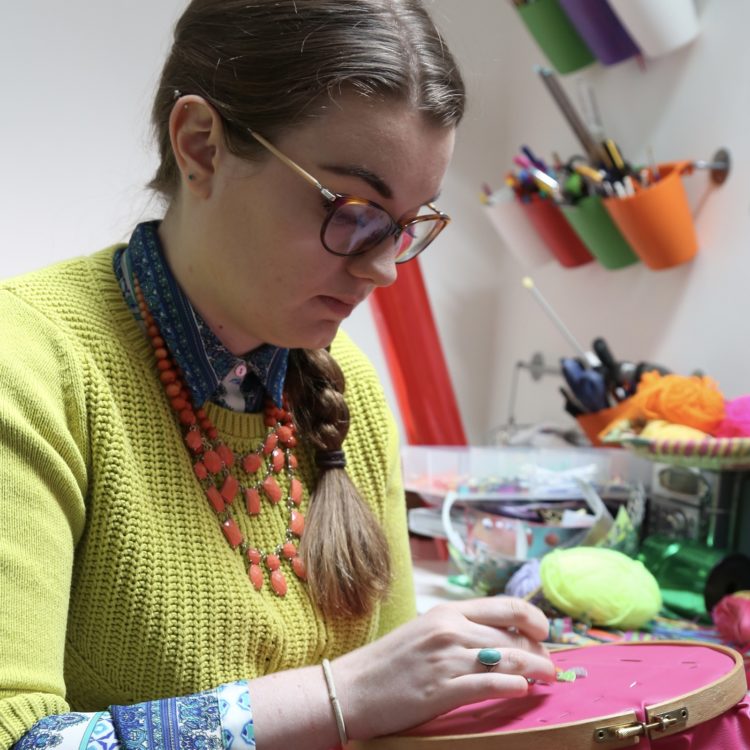
Jessica Grady is based in West Yorkshire, UK, where she is a member of Art Textiles Made in Britain. Her work has been exhibited internationally, and in 2018, she was awarded the ‘Under 30’s Scholar’ by The Embroiderers’ Guild. Jessica is also a passionate teacher who teaches stitch and recycling through various workshops and community projects.
Artist website: www.jessicagrady.co.uk
Facebook: www.facebook.com/jessicagradyembroideryartist
Instagram: @jessica_rosestitch
Alice Fox is a beachcomber extraordinaire. Not only does she collect shells, stones and other treasures, but she also bottles the seawater in which they are found. She then brings the water back to her studio where she can authentically recreate the ocean’s impact on her found treasures.
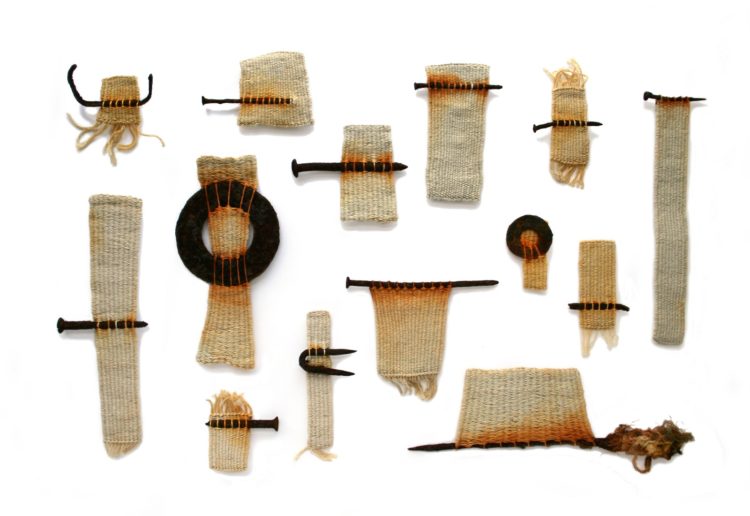
‘For this collection, I was inspired by a variety of rusty objects collected in various coastal locations. I wanted to exploit their potential to stain cloth, so I repeatedly dipped the altered objects in seawater over several days to replicate the action of the tides. The resulting collection appeared as though it might have been washed up by the tide.’
Alice also wanted to explore how to incorporate the rusted objects into a constructed surface versus attaching them to cloth. She embedded the objects in woven surfaces by either directly weaving on an object itself or attaching it in some other way unique to the object. Woven cotton yarn was mostly used on a simple frame to build a tapestry weave structure. Once the weaving was complete, the dipping process began, and the results speak for themselves.
‘I see found objects and gathered materials as tangible links to places where I’ve spent time. I’ve combed beaches all over the UK, including the west coast of Scotland, the Yorkshire coast and Wales. My textile art forms a record of those experiences of “place,” and my found objects often serve as the starting point to my creative response.’
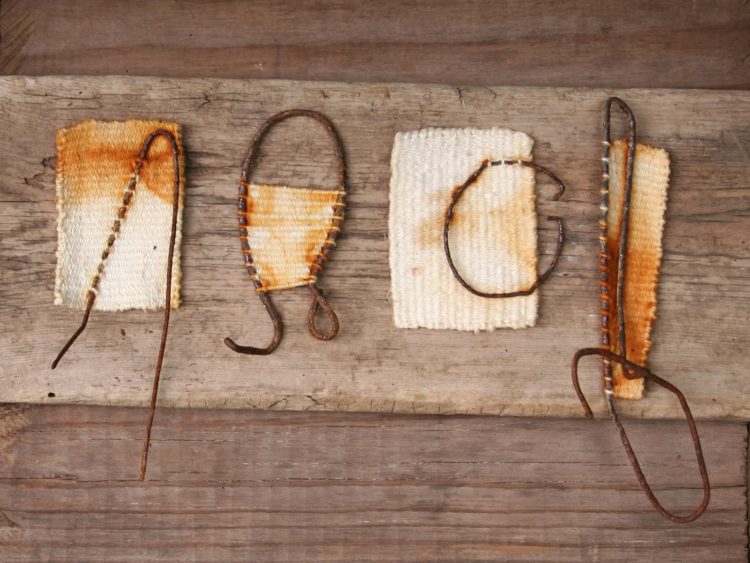
This collection of objects is part of a larger project called Tide Marks in which Alice focused upon the places where land meets sea. It features a series of art works on paper and fabric that provide testament to the sea’s role in both collecting and returning treasures, as well as its ability to make marks in ways only natural tides could produce.
Alice has also created many works with limpet shells on which she makes tiny holes for stitching and weaving. Plastics, shells, bones, metal, stone and paper are other favourite finds to use in her textile art.
‘Each of my found objects becomes a technical exercise in how best to interact with it. Some things I can make holes in and attach constructed elements. Other objects I will wrap, weave into or bind. Sustainability is at the heart of my practice, so I’m careful to only take that which is allowed.’
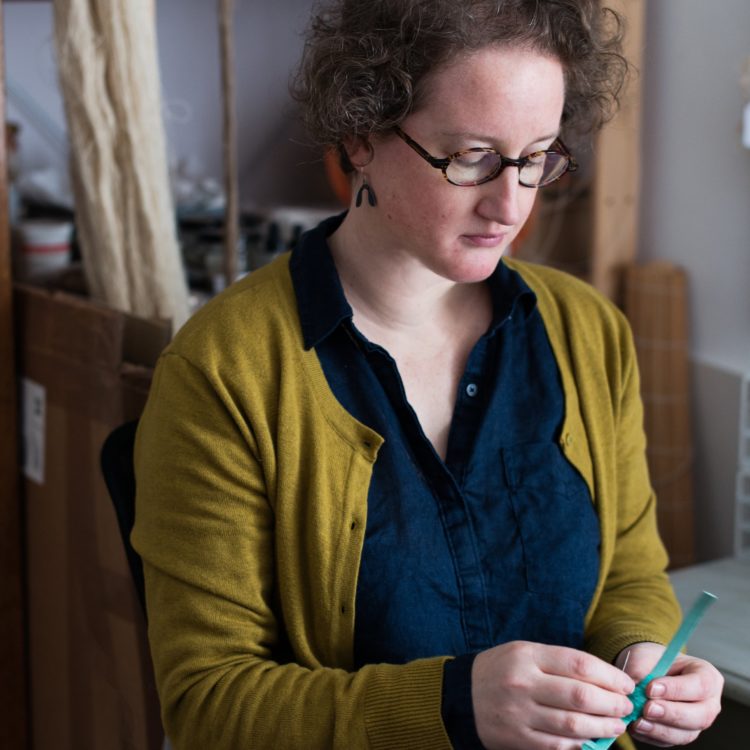
Alice Fox is based in Saltaire, Bradford, West Yorkshire, UK. She holds an MA in Creative Practice from Leeds Arts University, and she exhibits and teaches across the globe. She was shortlisted for the Janome Fine Arts Textile Award (2021) and received the Develop Your Creative Practice award from Arts Council England (2021).
Artist website: www.alicefox.co.uk
Facebook: www.facebook.com/alicefoxartist
Instagram: @alicefoxartist
What do you do when your vacuum cleaner breaks? Cover it in embroidery of course! That’s what Ulla-Stina Wikander did years back, and she’s been covering vintage appliances and other domestic tools ever since. Her works are rich and whimsical takes on household life, not to mention the importance of recycling.
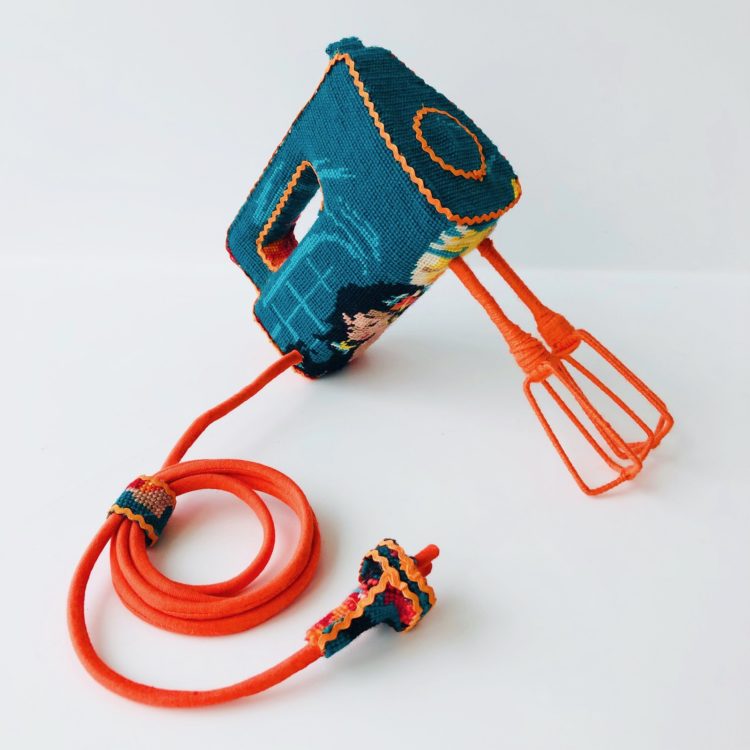
‘I used to work at the Gothenburg Opera House as a prop designer. I frequently visited flea markets searching for props, but I also started collecting old embroideries. I first covered some mirror frames and seats, but they weren’t very exciting. So, I thought to instead cover unexpected items, like my vacuum cleaner. The objects instantly became works of art, and people loved them.’
Ulla-Stina prefers working with items dating from the 1970s, and she’s covered most anything you can imagine: phones, a typewriter, irons, stiletto heels and even old tools. She also enjoys showcasing the feminist connection to her objects.
Ulla-Stina’s collection of embroideries is vast and features hundreds of motifs and images. She chooses embroideries that both touch her heart and will mechanically work best. She also wants to make sure the embroideries don’t distract from the objects themselves, but instead work together like a delightful duet.
‘It’s always difficult to choose the right embroidery and then cut it apart. There’s always a concern about destroying something that cannot be undone or that maybe I’ve chosen the wrong object for the embroidery. I also want to pay tribute to the women who have made the embroideries.’
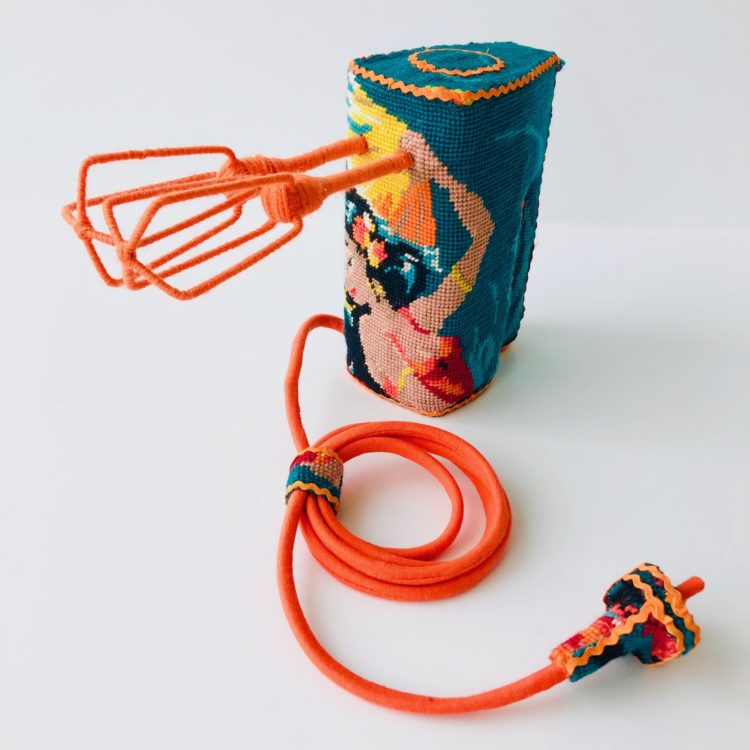
For this work, Ulla-Stina chose a wool embroidery featuring a Flamenco dancer, which she describes as a ‘fairly common’ design that is also a favourite. She first made a pattern in calico, and then carefully cut the embroidery in ways that showcased the embroidery’s motifs when viewed from all angles. She then layed the cut embroidery pieces on the mixer itself and stitched them together while wrapped around the mixer. She rarely uses glue if she can avoid it.
Once the mixer was covered, Ulla-Stina hand stitched zig zag ricrac over the seams. (she’ll often dye ric rac to match an embroidery’s colours.) The mixer blades were then wrapped with yarn, and the cord covered with lycra.
‘I want people to take a better look at the things we throw away, the things that are regarded as useless. My items become artefacts from a bygone era, disguised, dressed and camouflaged. I give them a second life in a new context.’
Ulla-Stina Wikander is based in Stockholm, Sweden, and has been working as an artist since 1986. She graduated from Göteborgs Konstskola, and her last solo exhibition was at Göteborgs Konstförening (2021). She has also exhibited in group shows around the world and at Art Basel Miami in 2019.
Artist website: www.ullastinawikander.com
Facebook: www.facebook.com/Ulla-Stina Wikander
Instagram: @uskonst
Hillary Fayle had always been interested in the natural world, but it wasn’t until she was teaching the ecosystem to kids at a summer camp that she first attempted to actually stitch on a leaf. After gazing at an oak tree for a bit and wondering about the possibilities, she collected a handful of leaves and started stitching.
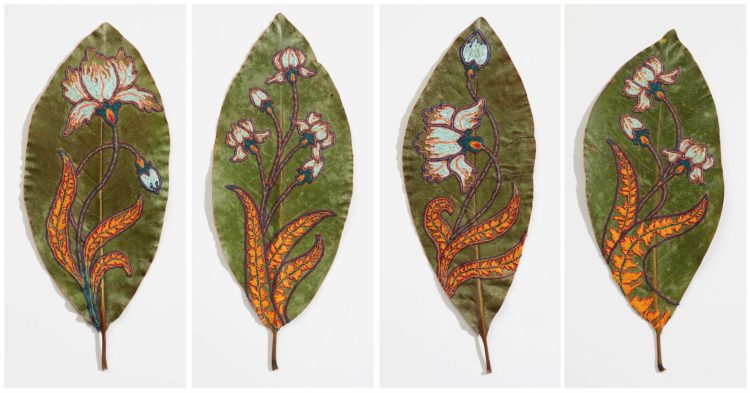
‘When it worked, it was amazing! I wasn’t just bringing bits of leaves together with stitch. I was also symbolically binding my passion for handcraft with my love for the natural world. I find my stitched leaves to be incredible icons of the natural world, and they speak powerfully to what can be achieved when we collaborate thoughtfully and act with care.’
Hillary uses both fresh and dried leaves. Her collection of found natural treasures is quite large, so she usually first sifts through the collection to find something that speaks to her.
She next sketches her designs and then transfers them onto the leaves either directly or by using a pricking method. Once a visual map is created, she begins to embroider, layering colour upon colour. She presses the leaves both during and after her stitching to help preserve them before they are ultimately finished and framed.
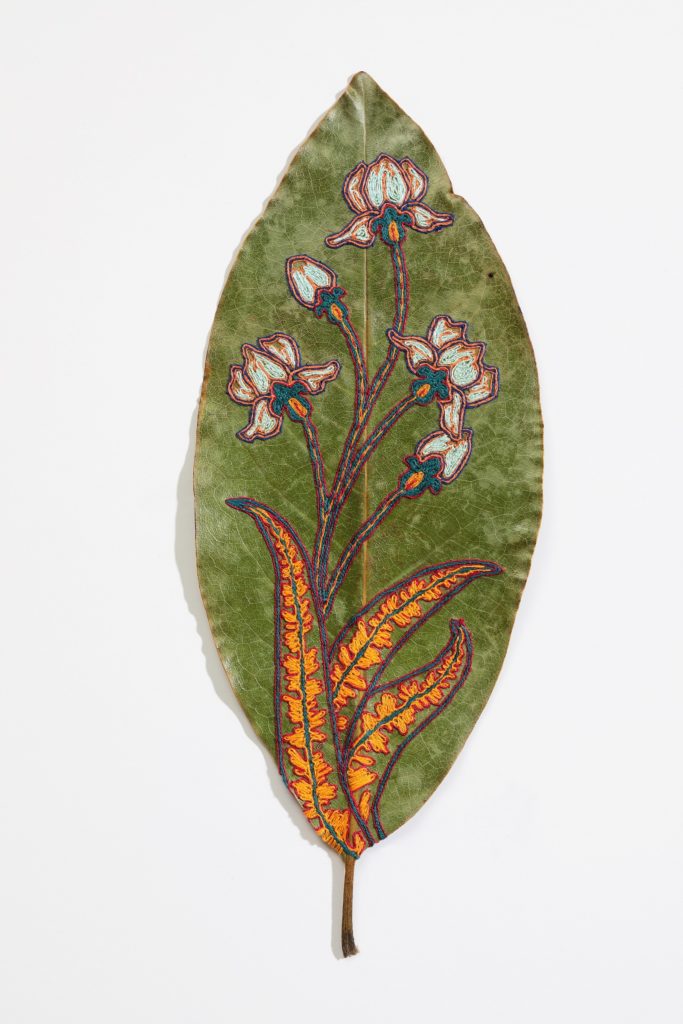
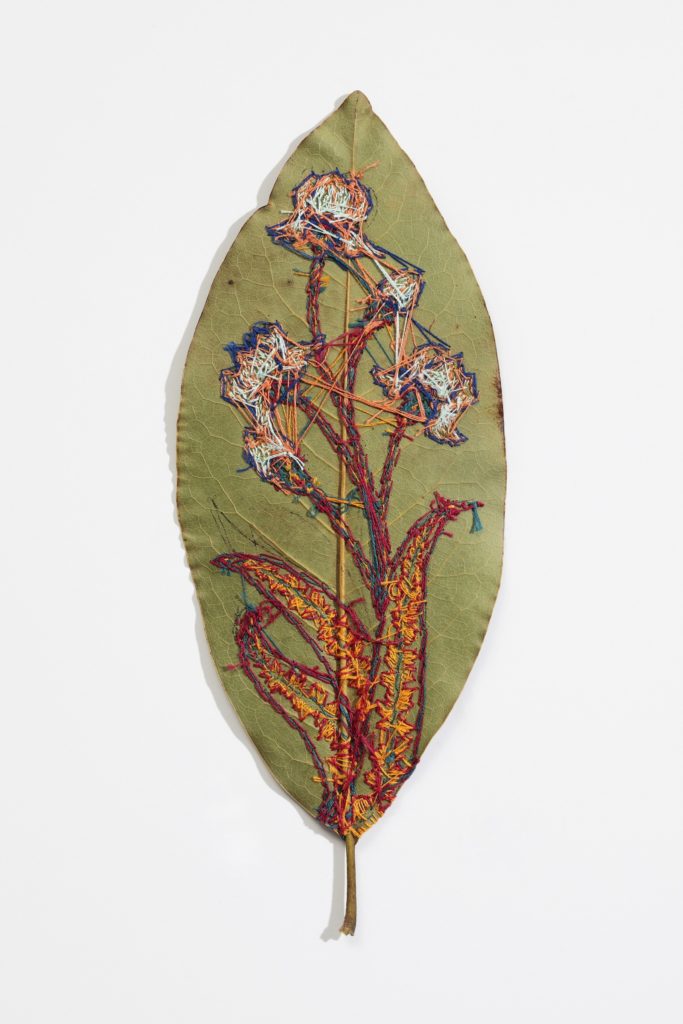
This work features a collection of embroidered magnolia leaves. The embroidery is almost entirely couched, which is one of Hillary’s favourite stitches. The designs are inspired by depictions of flowers and plants found on antique fabrics, as Hillary is a fan of historical textiles and techniques.
‘I love thinking about my hands echoing the gestures made by thousands of hands over thousands of years. Being connected to the lineage of people working with textiles, plants and the land feels very important to my work.’
Hillary views the objects she uses in her work as ‘gifts’ from nature. She mostly collects leaves, stones, feathers and sticks. She doesn’t always know how she’ll use her treasures when discovered, so she takes them back to her studio to wait for the right time.
‘I have a real interest in looking at the ground while I’m walking, and I tend to notice little bits left behind. Fragments of another life or story that are powerful and often very beautiful. The inexplicably complex patterns of leaves and feathers are mysterious and exquisite, so it feels natural to bring them back to the studio as either muse or material.’
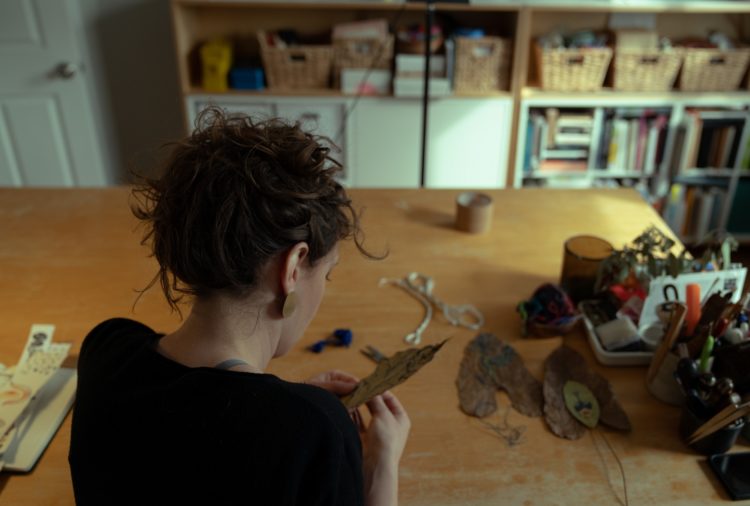
Hillary Waters Fayle is based in Virginia, US, where she is both an artist and educator. Her work is included in the collections of the United States Embassy to Sri Lanka, Columbo and Tangiers, Algeria. She has also collaborated with L’Occitane en Provence and the New York Botanical Garden.
Artist website: www.hillarywfayle.com
Instagram: @hillary.waters
Hannah Reeves can often be found at the enormous antique mall located just down the highway from her home. She scours the shelves for items that trigger ‘some feeling’ but interesting hand mirrors and hinged tins are her favourites.
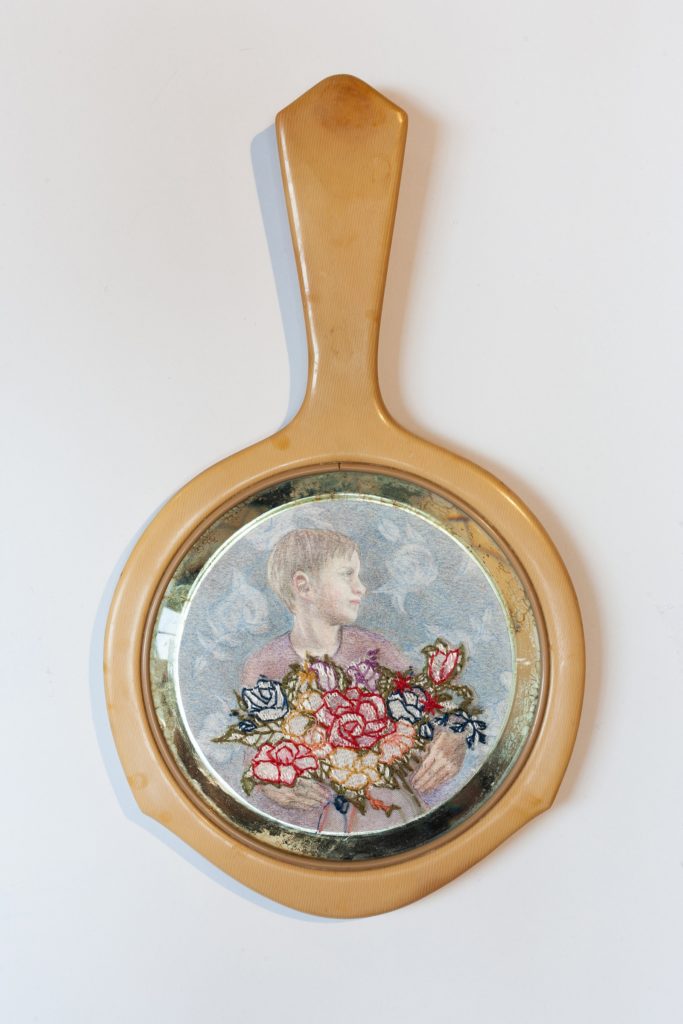
‘Objects with their own histories of use and preciousness are receptacles for memory and meaning. When an item is chosen with intuition and care and then matched with the right subject matter and media, it can become the setting for a story.’
This work is part of a series inspired by a Tennyson poem that mourns the loss of a dear friend and reflects upon the different forms grief takes over time. The 10-piece collection features drawing and stitchwork set into various tins, wall mirrors, hand mirrors and an ornate mirrored serving tray.
The title for this particular work comes from the poem’s line ‘I take the grasses of the grave’ in which the poet explores his desperate need for memento and the sad peace of watching nature’s self-renewal after death.
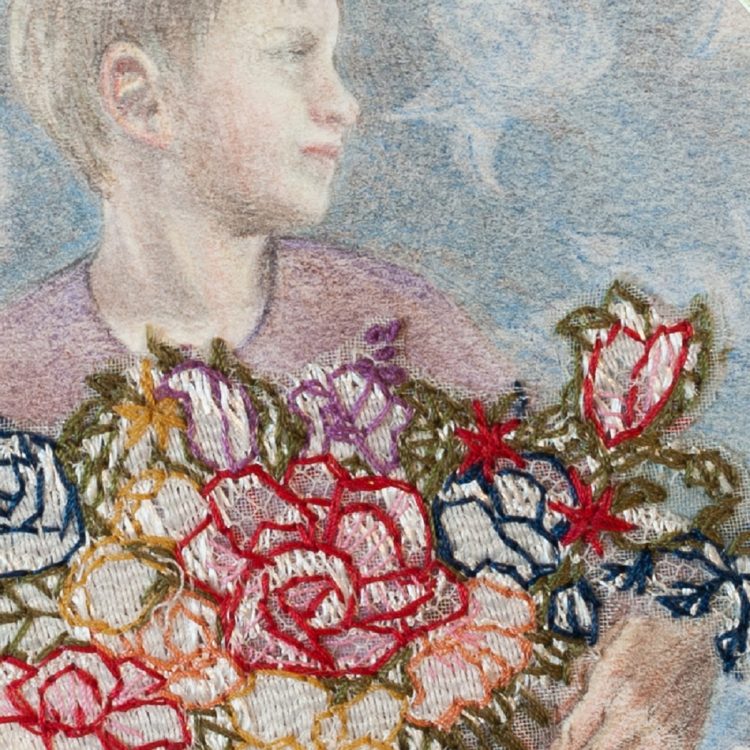
‘This piece was inspired by the death of my friend and mentor and his lovely relationship with my son, who is also my friend’s namesake. It depicts my son holding a bouquet of flowers as if a funerary offering that is set inside an antique hand mirror. I used mirrors as frames and substrates throughout the series to echo Tennyson’s reflection upon and examination of mortality.’
Hannah drew the image of her son on paper with chalk. She then stretched organdie in an embroidery hoop, laid it over the drawing and lightly marked where to stitch his bouquet. She then embroidered the bouquet with minute stitches using only a 30-weight two-ply all-purpose thread.
The organdie’s high thread count allowed her to skip across the weave and use traditional embroidery stitches such as stem stitch, satin stitch, french knots and freeform running stitches. Lastly, she backed the completed embroidery with fusible webbing to create a sort of patch and then attached it to the mirror with a very thin layer of Sobo glue.
‘Because my found objects incorporate an inherent sense of history, they allow me to talk about loss and memories. And the stories I create may be accurate or perhaps distorted by time and longing.’
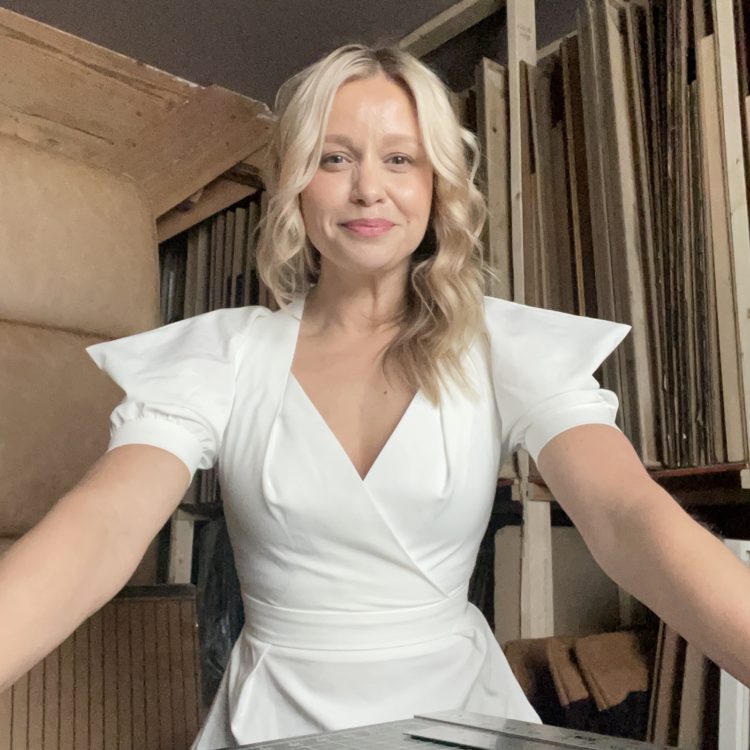
Hannah Reeves lives in Missouri, US, where she is always thinking about her connection to home, memory and the history of women’s work. She holds an MFA in Fibers from the University of Missouri where she also taught for a decade. She now runs the Sager Reeves Gallery in Columbia, Missouri.
Artist website: sagerreevesgallery.com/hannah-reeves-summary
Facebook: www.facebook.com/hannah.reeves.56863
Instagram: @hannahandherthings
The use of found objects in art often relates to environmental sustainability. Check out these artists who are creating incredible works with recycled materials.